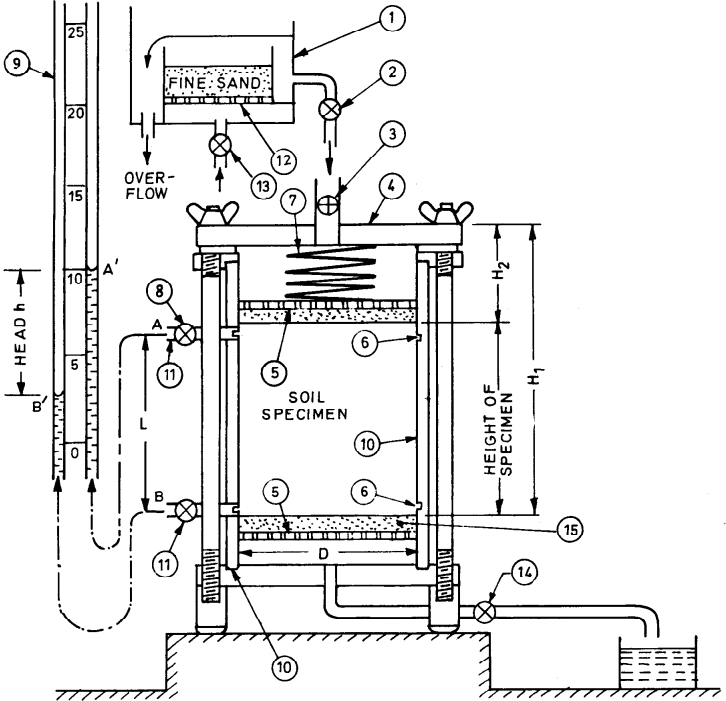
Fig.1 Cylinder Diameter
Permeameter
As shown in Fig., the permeameter shall have specimen cylinders
with minimum diameters approximately 8 or 12 times the maximum
particle size in accordance with Table 1. The permeameter shall be fitted with:
a) A porous disc or suitable reinforced screen at the bottom with a permeability
greater than that of the soil specimen, but with openings sufficiently small
(not larger than 10 percent of finer size of the soil to be tested) to prevent
the movement of particles;
b) Manometer outlets for measuring the loss of head,
h over a length, L, equivalent to at least
the diameter of the cylinder;
c) A porous disc or suitable reinforced screen
with spring attached to the top, or any other
device for applying a light spring pressure of 2
to 4 kg total load when the top plate is attached in place.
This will hold the placement density and volume of soil without significant
change during the saturation of the specimen
and the permeability testing to satisfy the
requirement that there should be no soil
volume change during a test.
Note: Perforated metal disc may also be used for the test.
Constant-Head Filter Tank

Fig.2 Constant Head Permeameter
1) Constant-head filter tank (NTC)
2) Filter tank valve
3) Inlet valve
4) Top plate
5) Porous disc or screen
6) Screened manometer groove
7) Spring
8) Manometer valve
9) Manometer tubes
10) Metal or transparent acrylic plastic cylinder
11) Manometer outlet
12) Screen
13) Tap water valve
14) Outlet valve
15) Gravel filter
This shall be as shown in Fig.,
to supply water and shall be fitted with
suitable control valves to prevent formation
of air bubbles in the soil voids. The size of
the constant head filter tank shall be large
enough to meet the demand depending upon the
permeability of the specimen.
Note: There are several methods of reducing air content of
water, such as: (a) by boiling,(b) by spraying water intoa partial
vacuum, (c) to use water having higher temperature, at least 5” C
more than that of the soil specimen under test, and(d) by running
water before use through a porous fine grained material so that
the air is entrapped in the interstices of the material. Out of all
these methods of de-airing water, the last method of passing tap
water through filter is less expensive and more suitable specially when
large quantities of de-aired water are required to be used. It will be
essential that the filter material should be of finer grade than that of
thesoilto be tested otherwiseairmaycomeout of the
solutioA in water while passing through the soil
mass. But still, if preferred, the de-aired water prepared by
boiling or spraying through partial vacuum may be used.
Large Funnels
These shall be fitted with special cylindrical spout,
25 mm in diameter for 10.00 mm maximum size
particles and 13 mm in diameter for 2.00 mm
maximum size particles. The length of the
spout should be greater than the full
length of the permeability chamber
at least by 160 mm.
Specimen Compaction Equipment
Compaction equipment as deemed desirable may be used. The following are suggested:
- A vibrating tamper fitted with a tamping foot 50 mm in diameter;
- A sliding tamper with a tamping’foot 50 mm in diameter and a rod for sliding weights of 100 g (for sands) to 1 kg (for soils with a large gravel content), having an adjustable height of drop to 100 mm for sands and 200 mm for soils with large gravel contents.
Vacuum Pump or Water Faucet Aspirator
for evacuating and for saturating soil specimen under full vacuum (see Fig. Constant Head Permeameter)
Balance
It shall be of 2 kg capacity and sensitive to 1 g.
Scoop
With a capacity of 100 g of soil.
Miscellaneous Apparatus
Thermometers, clock with sweep second hand, 250 ml graduated cylinder and mixing pan.